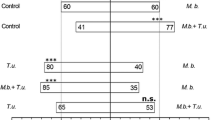Abstract
Induction of plant defense in response to herbivory includes the emission of synomones that attract the natural enemies of herbivores. We investigated whether mechanical damage to Brussels sprouts leaves (Brassica oleracea var.gemmifera) is sufficient to obtain attraction of the parasitoidCotesia glomerata or whether feeding byPieris brassicae caterpillars elicits the release of synomones not produced by mechanically damaged leaves. The response of the parasitoidCotesia glomerata to different types of simulated herbivory was observed. Flight-chamber dual-choice tests showed that mechanically damaged cabbage leaves were less attractive than herbivore-damaged leaves and mechanically damaged leaves treated with larval regurgitant. Chemical analysis of the headspace of undamaged, artificially damaged, caterpillar-infested, and caterpillar regurgitant-treated leaves showed that the plant responds to damage with an increased release of volatiles. Greenleaf volatiles and several terpenoids are the major components of cabbage leaf headspace. Terpenoids are emitted in analogous amounts in all treatments, including undamaged leaves. On the other hand, if the plant is infested by caterpillars or if caterpillar regurgitant is applied to damaged leaves, the emission of green-leaf volatiles is highly enhanced. Our data are in contrast with the induction of more specific synomones in other plant species, such as Lima bean and corn.
Similar content being viewed by others
References
Baldwin, I.T. 1990. Herbivory simulations in ecological research. Trends in Ecology and Evolution 5(3):91–93.
Blaakmeer, A., Geervliet, J.B.F., van Loon, J.J.A., Posthumus, M.A., van Beek, T.A., andde Groot, A. 1994. Comparative headspace analysis of cabbage plants damaged by two species ofPieris caterpillars: Consequences for in-flight host location by Cotesia parasitoids.Entomol. Exp. Appl. Vol. 73. In press.
Dicke, M. 1994. Local and systemic production of volatile herbivore-induced terpenoids: Their role in plant-carnivore mutualism.J. Plant Physiol 143:465–472.
Dicke, M., andSabelis, M.W. 1988. How plants obtain predatory mites as bodyguards.Neth. J. Zool. 38:148–165.
Dicke, M., van Beek, T.A., Posthumus, M.A., Ben Dom, N., van Bokhoven, H., andde Groot, A.E. 1990a. Isolation and identification of volatile kairomone that affects acarine predator-prey interactions. Involvement of host plant in its production.J. Chem. Ecol. 16(2):381–396.
Dicke, M., Sabelis, M.W., Takabayashi, J., Bruin, J., andPosthumus, M.A. 1990b. Plant strategies in manipulating predator-prey interactions through allelochemicals: prospect for application in pest control.J. Chem. Ecol. 16:3091–3118.
Dicke, M., van Baarlen, P., Wessels, R., andDijkman, H. 1993. Herbivory induces systemic production of plant volatiles that attract predators of the herbivore: Extraction of endogenous elicitor.J. Chem. Ecol. 19(3):581–599.
Hatanaka, A. 1993. The biogeneration of green ododur by green leaves.Phytochemistry 34:1201–1208.
McCall, P.J., Turlings, T.C.J., Lewis, W.J., andTumlinson, J.H. 1993. The role of plant volatiles in host location by the specialist parasitoidMicroplitis crocepies Cresson (Braconidae: Hymenoptera).J. Insect. Behav. 6(5):625–639.
Nordlund, D.A., Lewis, W.J., andAltieri, M.A. 1988. Influences of plant produced allelochemicals on the host prey selection behaviour of entomophagous insects, pp. 65–90,in P. Barbosa and D.K. Letourneau (eds.). Novel Aspects of Insect-Plant Interactions. Wiley, New York.
Sabelis, M.W., Afman, B.P., andSlim, P.J. 1984. Location of distant spider mite colonies byPhytoseiulus persimilis: Localization and extraction of kairomone.Acarology 6(1):431–440.
Sokal, R.R., andRohlf, F.J. 1981. Biometry. W.H. Freeman, New York.
Steinberg, S., Dicke, M., Vet, L.E.M., andWanningen, R. 1992. Response of the braconid parasitoidCotesia (Apanteles)glomerata (L.) to volatile infochemicals: Effects of bioassay setup, parasitoid age and experience and barometric flux.Entomol. Exp. Appl. 63:163–175.
Steinberg, S., Dicke, M., andVet, L.E.M. 1993. Relative importance of infochemicals from first and second trophic level in long-range host location by the larval parasitoidCotesia glomerata.J. Chem. Ecol. 19(1):47–60.
Takabayashi, J., andDicke, M. 1992. Response of predatory mites with different rearing histories to volatiles of uninfested plants.Entomol. Exp. Appl. 64:187–193.
Takabayashi, J., Takashi, N., andTakahashi, S. 1991a. Plants produce attractants forApanteles kariyai, a parasitoid ofPseudaletia separata; cases of “communication” and “misunderstanding” in plant-parasitoid interactions.Appl. Entomol. Zool. 26(2):237–243.
Takabayashi, J., Dicke, M., andPosthumus, M.A. 1991b. Variation in composition of predator-attracting allelochemicals emitted by herbivore-infested plants: Relative influence of plants and herbivore.Chemoecology 2:1–6.
Takabayashi, J., Dicke, M., Takahashi, S., Posthumus, M.A., andvan Beek, T.A. 1994. Leaf age affects composition of herbivore-induced synomones and attraction of predatory mites.J. Chem. Ecol. 20:373–386.
Turlings T.C.J., Tumlinson, J.H., andLewis, W.J. 1990. Exploitation of herbivore-induced plant odors by host seeking parasitic wasps.Science 250:1251–1253.
Turlings, T.C.J., McCall, P.J., Alborn, H.T., andTumlinson, J.H. 1993a. An elicitor in caterpillar oral secretions that induces corn seedlings to emit chemical signals attractive to parasitic wasps.J. Chem. Ecol. 19(3):411–425.
Turlings, T.C.J., Wäckers, F.L., Vet, L.E.M., Lewis, W.J., andTumlinson, J.H. 1993b. Learning of host-finding cues by Hymenopterous parasitoids, pp. 51–78,in D.R. Papaj and A.C. Lewis (eds.). Insect Learning. Chapman and Hall, New York.
Vet, L.E.M., andDicke, M. 1992. Ecology of infochemical use by natural enemies in a tritrophic context.Annu. Rev. Entomol. 37:141–172.
Visser, J.H., van Straten, S., andMaarse, H. 1979. Isolation and identification of volatiles in the foliage of potato,Solanum tuberosum, a host plant of the Colorado beetle,Leptinotarsa decemlineata.J. Chem. Ecol. 5:11–23.
Whitman, D.W., andEller, F.J. 1990. Parasitic wasps orient to green leaf volatiles.Chemoecology 1:69–75.
Whitman, D.W., andEller, F.J. 1992 Orientation of Microplitis croceipes (Hymenoptera: Braconidae) to green leaf volatiles: dose-response curves.J. Chem. Ecol. 18(10):1743–1753.
Author information
Authors and Affiliations
Rights and permissions
About this article
Cite this article
Mattiacci, L., Dicke, M. & Posthumus, M.A. Induction of parasitoid attracting synomone in brussels sprouts plants by feeding ofPieris brassicae larvae: Role of mechanical damage and herbivore elicitor. J Chem Ecol 20, 2229–2247 (1994). https://doi.org/10.1007/BF02033199
Received:
Accepted:
Issue Date:
DOI: https://doi.org/10.1007/BF02033199




